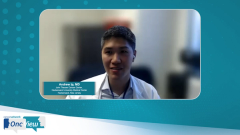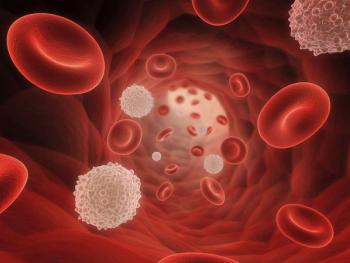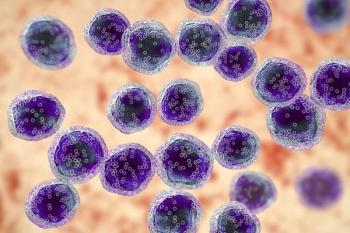
Evolving Treatment Paradigms in Mantle Cell Lymphoma
Andre H. Goy, MD, and Andrew Ip, MD, discuss the ways in which treatment paradigms for mantle cell lymphoma (MCL) have recently shifted.
Episodes in this series

Transcript:
Andrew Ip, MD: My name is Andrew Ip. I am a lymphoma specialist at John Theurer Cancer Center in Hackensack, New Jersey.
Andre H. Goy, MD: Hi everyone. My name is Andre Goy. I'm the chair of oncology and chief at Hackensack Meridian Health and also the chief of the Lymphoma Department at John Theurer Cancer Center in Hackensack, New Jersey. And I'm looking forward to the discussion with Dr Andrew Ip, a great lymphoma expert.
Andrew Ip, MD: Thank you. So, in segment 1, we'll be talking about updates in mantle cell lymphoma. Dr Goy, who are the experts in mantle cell lymphoma? Generally speaking, how do you see treatment paradigms for mantle cell lymphoma in the past few years have changed?
Andre H. Goy, MD: The challenge of mantle cell lymphoma becoming chemo-resistant has led to a lot of clinical research, and we need to be thankful to investigators and patients who have helped us collaboratively to make progress. We went from standard chemoimmunotherapy that doesn't work to consolidation with transplant, which has started to lead to median PFS [progression-free survival] in excess of 8 years from induction, and maintenance therapy adding to the clinical benefit. What I would say has become the standard over the years was the dichotomy that if you can qualify for those intensive regimens, as I just mentioned, you're going to do better than if you are older when you usually got standard chemoimmunotherapy.
This being said, this paradigm has been shifting because we have been having a clearly greater awareness of the significant biological heterogeneity of mantle cell lymphoma and have moved from clinical prognostic factors models, such as MIPI [Mantle Cell Lymphoma International Prognostic Index], beta-2, LDH [lactate dehydrogenase], etc, and even blastoid variant on the microscope to really a more biological signature that has an impact on how we treat patients. None of the prognostic models that we have been using in general in lymphoma really helps you decide on the treatment. They just tell you the prediction of doing well over time but [do] not help you modify the treatment.
And now as I mentioned, in understanding biological heterogeneity we know that patients, for example, who have P53 abnormalities or complex karyotype or deletion 17p do very poorly with standard therapy. And I would say that has changed your position on the dichotomy is really starting to take into account the underlying biological characteristics of the disease to really refine the treatment. And I'm sure we'll discuss this further during this conversation.
Andrew Ip, MD: I want to go further on that point since, as you pointed out, there's great heterogeneity of the biology of mantle cell lymphoma and I think both you and I know that consolidation, even stem cell transplant, may not be the right answer for especially those who have maybe chemotherapy-resistant or TP53-resistant disease. And maybe you have to have a smarter approach using BTK inhibitors and other targeted drugs. Do you think some of the differences in those outcomes and why we've changed how we treat upfront mantle cell, especially, is because of the maybe chemo-resistant nature of some of the different mantle cell heterogeneity? Or is it because the targeted BTK inhibitor is just better? Or is it a little bit of both?
Andre H. Goy, MD: I think it's a little bit of both. We have learned in the relapsed/refractory setting where chemotherapy is not an option. Even high-dose therapy in transplant and as you know, the only way to cure relapsed/refractory mantle cell lymphoma was an autologous transplant, which is a form of cell therapy, which is not necessarily feasible given the median age at relapse is in the late 60s, early 70s, and finding a donor with at least 50% chronic GVH [graft-vs-host disease]. This was an issue, and we have developed 7 agents, which are now approved in the relapsed/refractory setting, and they are starting to be brought into the frontline setting for exactly what you referred to, Andrew high-risk patients that do very poorly.
To give an example to the audience, a patient who has a deletion 17p, particularly a mutation of TP53, and often this is combined anyway when you look deeply. These patients do very poorly, even with [an] intensive regimen, the median survival is roughly 18 months in that setting, well beyond the blastoid variant that often carries these abnormalities. We’re all exploring new things for those patients, and Michael Wang, MD, at MD Anderson did the study called the WINDOW-1 trial, where they did a combination of a biological doublet prior to hyper-CVAD, and others have done this with other chemotherapy as a consolidation. And the idea is to treat this patient with nonchemotherapy, nongenotoxic, and to try to give them less chemotherapy. The results are preliminary but promising. There's no randomized [trial], but I think this is where the field is heading.
The doublet might not be sufficient in a very high-risk patient, but we know that these doublets in a low-risk mantle cell indolent or low bulk—patients on ibrutinib and rituximab, for example, do really well from high MRD [minimal residual disease], 75% MRD negative, from the GELTAMO trial, and others. The triplets also lead to a very high CR [complete remission] rate and MRD negativity, and are very durable. And I think as you mentioned, we will see the shift of the landscape to high-risk patients going more and more towards nonchemotherapy options. We don't know if they really need chemotherapy at this point. There are ongoing objective clinical trials. And patients who aren’t candidates for chemotherapy that could do really well with these novel approaches.
Transcript edited for clarity.
Newsletter
Stay up to date on recent advances in the multidisciplinary approach to cancer.
























































































